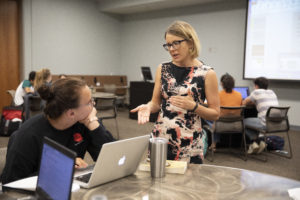As an historian of Latin America who emphasizes an intersectional approach toward teaching the past, I engage in three core pedagogical categories in the classroom: methodological compassion; critical thinking; and active-learning. Throughout, I center student learning as a process rather than an outcome. This approach has, in the words of some former students, “challenged” students to “think critically about history” including “how history gets told.”
 The people I research and teach about—often poor, women of color—bore the brunt of societal violence in Latin American history. I bring this awareness of oppression to the classroom in my attempts to decolonize the curriculum. As such, I am committed to placing the lived experience of the body at the center of my teaching and research. With my students, we humanize the subjects we discuss so as not to turn them into objects, a methodology that requires an intersectional reading of historical documents. To do so, we focus on texts written by and for marginalized subjects, emphasizing lived experience. For example, in the course “Women, Gender, and Sexuality in Latin America,” I assigned the diary of a poor, Afro-Brazilian woman named Carolina Maria de Jesus, who picked trash for a living in 1960s São Paulo, Brazil. In discussing the intersection of race and gender in de Jesus’s lived experience, I asked students to pinpoint specific diary passages in which they found she discussed an intersectional identity. In the next class, students discussed de Jesus’s writings on Black motherhood, sexuality, and racial politics, engaging in a lively discussion of de Jesus’s ability to theorize race and gender “from the ground up.”
The people I research and teach about—often poor, women of color—bore the brunt of societal violence in Latin American history. I bring this awareness of oppression to the classroom in my attempts to decolonize the curriculum. As such, I am committed to placing the lived experience of the body at the center of my teaching and research. With my students, we humanize the subjects we discuss so as not to turn them into objects, a methodology that requires an intersectional reading of historical documents. To do so, we focus on texts written by and for marginalized subjects, emphasizing lived experience. For example, in the course “Women, Gender, and Sexuality in Latin America,” I assigned the diary of a poor, Afro-Brazilian woman named Carolina Maria de Jesus, who picked trash for a living in 1960s São Paulo, Brazil. In discussing the intersection of race and gender in de Jesus’s lived experience, I asked students to pinpoint specific diary passages in which they found she discussed an intersectional identity. In the next class, students discussed de Jesus’s writings on Black motherhood, sexuality, and racial politics, engaging in a lively discussion of de Jesus’s ability to theorize race and gender “from the ground up.”
My emphasis on divergent histories informs how students critically think through course assignments. I teach students how to engage in historical inquiry, including original research into primary historical sources. All assignments are research-based and cumulative, which students have found “purposeful.” For example, in my 3000-level history courses, the student picks a research topic of their choice at the beginning of the semester. The student then writes three short primary-source essays as they research their topic throughout the semester. These essays form the basis for a final project. In one semester, this was a class poster conference, where students presented their research to a UGA audience at Special Collections in poster form. Students have found this type of assignment “extraordinarily helpful and analytical” as “each paper added another layer to [their] research.” Others felt they gained “practical research experience,” since the class approached research in a step-by-step manner, from understanding the difference between a primary and secondary source, to finding resources in the library, to analyzing a historical source critically. This structure teaches students to engage in research and writing continually throughout the semester and thus provides “accountability.” Because students engage in research-based assignments and not exams, they have felt that class time, based in discussion, becomes more meaningful.
Finally, in all my courses I teach analytical writing based on the peer-reviewed academic process of revise-and-resubmit. Any essay a student writes in my class has three components: the initial essay, which is considered a final project and not a rough draft; a revised essay based on my feedback, and a short paragraph summary of the changes the student made in their revised version. If students disagree with my comments, I welcome them to explain why in their paragraph summary, giving them the opportunity to explain their approach or clarify any questions. I implemented this process in spring 2021, and students have been enthusiastic about its effects. Numerous students expressed that they felt they learned to write “concisely and clearly” and gained confidence in relation to their writing skills. The revision process allows students to understand how scholarly writing works. Most importantly, the system has allowed for students “to learn from their mistakes.”
These classroom activities form the core of my teaching approach. I center process over outcome, student learning over grades, and critical thinking over getting things done quickly. Underpinning these practical approaches is my compassionate efforts to teaching the history of those often silenced in a way that is both rigorous yet humanizing. Students can take this approach with them beyond the walls of the classroom.